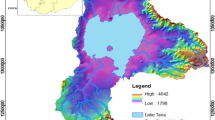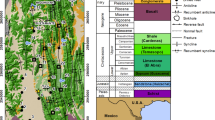Abstract
The Manuguru geothermal area, situated in the Telangana state, is one of the least explored geothermal fields in India. In this study, the chemical characteristics of the groundwater (thermal and non-thermal waters) are investigated to elucidate the source of the solutes dissolved in the water and to determine the approximate residence time of the thermal waters. The major hydrogeochemical processes controlling the groundwater geochemistry have been deciphered using multivariate statistical analysis, conventional graphical plots and geochemical modelling (PHREEQC). Geochemically different groundwater clusters (bicarbonate type, bicarbonate–chloride type and chloride type) can clearly be identified from the chemometric analysis, i.e. PCA and HCA. Thermal waters are mostly Na–HCO3 type having low EC and TDS compared to non-thermal groundwaters. Silicate weathering and ion exchange mainly contribute to the dissolved ion budget in the groundwater of the study area. The carbon isotopic composition of DIC (δ13C) points to silicate weathering with soil CO2 coming from C3 type of plants. Stable isotopes (δ18O, δ2H) data confirm the meteoric origin of the thermal waters with no oxygen-18 shift. The low tritium values of the thermal water samples reveal the long circulation time (> 50 years) of the recharging waters. Radiocarbon dating (14C) shows that the approximate residence time of the thermal waters ranges from 9952 to 18,663 year BP (before present).










Similar content being viewed by others
References
Ahmad M, Akram W, Hussain SD, Sajjad MI, Zafar MS (2001) Origin and subsurface history of geothermal water of Murtazabad area, Pakistan—an isotopic evidence. Appl Radiat Isot 55:731–736
APHA (American Public Health Association) (1995) Standard methods for the examination of water and wastewater, 19th edn. American Public Health Association, Washington, DC, pp 4–122
Appelo CAJ, Postma D (1993) Geochemistry, Groundwater and Pollution. A.A.Balkema, Rotterdam
Barbieri M, Nigro A, Petitta M (2017) Groundwater mixing in the discharge area of San Vittorino Plain (Central Italy): geochemical characterization and implication for drinking uses. Environ Earth Sci 76:393. https://doi.org/10.1007/s12665-017-6719-1
Battistel M, Hurwitz S, Evans WC, Barbieri M (2016) The chemistry and isotopic composition of waters in the low-enthalpy geothermal system of Cimino-Vico Volcanic District, Italy. J Volcanol Geotherm Res 328:222–229
Cartwright I (2010) Using groundwater geochemistry and environmental isotopes to assess the correction of 14C ages in a silicate-dominated aquifer system. J Hydrol 382:174–187
CGWB (Central Ground Water Board of India) (2013) Ground water brochure. Khammam district, Andhra Pradesh, pp 1–22
Chandrasekharam D, Rao VG, Jayaprakash SJ (1996) Geothermal energy potential and direct use of geothermal springs, Godavari valley, Andhra Pradesh. Geol Surv Ind Spl Publ 45:155–161
Chatterjee S, Sarkar A, Deodhar AS, Biswal BP, Jaryal A, Mohokar HV, Sinha UK, Das A (2017) Geochemical and isotope hydrological characterisation of geothermal resources at Godavari valley, India. Environ Earth Sci 76:97. https://doi.org/10.1007/s12665-017-6411-5
Clark ID, Fritz P (1997) Environmental isotopes in hydrogeology. Lewis Publishers, New York, p 328
Cloutier V, Lefebvre R, Therrien R, Savard MM (2008) Multivariate statistical analysis of geochemical data as indicative of the hydrogeochemical evolution of groundwater in a sedimentary rock aquifer system. J Hydrol 353:294–313
Craig H (1961) Isotopic variations in meteoric water. Science 133:1702–1703
Das A, Krishnaswami S, Bhattacharya SK (2005) Carbon isotope ratio of dissolved inorganic carbon (DIC) in rivers draining the Deccan Traps, India: sources of DIC and their magnitudes. Earth Planet Sci Lett 236:419–429
Davis JC (1986) Statistics and data analysis in geology. Wiley, New York
Drever JI (1997) The geochemistry of natural waters, 3rd edn. Prentice Hall, Upper Saddle River
Edmunds WM (2009) Geochemistry’s vital contribution to solving water resource problems. Appl Geochem 24:1058–1073
Epstein S, Mayeda T (1953) Variation of 18O contents of water from natural sources. Geochim Cosmochim Acta 4:213–224
Faure G (1998) Principles and applications of geochemistry, 2nd edn. Prentice Hall, Upper Saddle River
Gaillardet J, Dupre B, Louvat P, Allegre CJ (1999) Global silicate weathering and CO2 consumption rates deduced from the chemistry of large rivers. Chem Geol 159:3–30
Garrels RM, Mackenzie FT (1971) Evolution of sedimentary rocks. W. W. Norton & Co., New York
Gat JR (1981) Groundwater. In: Gat JR, Gonfiantini R (eds) Stable isotope hydrology—deuterium and oxygen-18 in the water cycle: Vienna. International Atomic Energy Agency, Wien, pp 223–240
Gibbs RJ (1970) Mechanisms controlling world water chemistry. Science 170(3962):1088–1090
Giggenbach WF (1992) Isotopic shift in waters from geothermal and volcanic systems along convergent plate boundaries and their origin. Earth Planet Sci Lett 113:495–510
Güler C, Thyne GD, McCray JE, Turner KA (2002) Evaluation of graphical and multivariate statistical methods for classification of water chemistry data. Hydrogeol J 10(4):455–474
Harvey CF (2002) Groundwater flow in the Ganges delta. Science 296:1563
Holland HD (1978) The chemistry of the atmosphere and oceans. Wiley, New York
Jankowski J, Acworth RI, Shekarforoush S (1998) Reverse ion-exchange in a deeply weathered porphyritic dacite fractured aquifer system, Yass, New South Wales, Australia. In: Arehart GB, Hulston JR (eds) Ninth international symposium on water–rock interaction. A.A. Balkema, Rotterdam, pp 243–246
Jones IC, Banner JL, Humphrey JD (2000) Estimating recharge in a tropical karst aquifer. Water Resour Res 36:1289–1299
Lakey B, Krothe NC (1996) Stable isotopic variation of storm discharge from a perennial karst spring, Indiana. Water Resour Res 32:721–731
Leybourne MI, Clark ID, Goodfellow WD (2006) Stable isotope geochemistry of ground and surface waters associated with undisturbed massive sulphide deposits; constraints on origin of waters and water–rock reactions. Chem Geol 231:300–325
Liu CW, Jang CS, Chen CP, Lin CN, Lou KL (2008) Characterization of groundwater quality in Kinmen Island using multivariate analysis and geochemical modeling. Hydrol Process 22:376–383
Mast MA, Drever JI, Baron JS (1990) Chemical weathering in the loch vale watershed, Rocky Mountain National Park, Colorado. Water Resour Res 26:2971–2978
McLean W, Jankowski J, Lavitt N (2000) Groundwater quality and sustainability in an alluvial aquifer, Australia. In: Sililo O et al (eds) XXX IAH congress on groundwater: past achievements and future challenges. A.A. Balkema, Rotterdam, pp 567–573
Melloul A, Collin M (1992) The ‘principal components’ statistical method as a complementary approach to geochemical methods in water quality factor identification; application to the Coastal Plain aquifer of Israel. J Hydrol 140:49–73
Mondal NC, Singh VP, Singh VS, Saxena VK (2010) Determining the interaction between groundwater and saline water through groundwater major ions chemistry. J Hydrol 388(1):100–111
Moore JN, Simmons SF (2013) More power from below. Science 340(6135):933–934. https://doi.org/10.1126/science.1235640
Mukherjee A, Fryar AE (2008) Deeper groundwater chemistry and geochemical modeling of the arsenic affected western Bengal basin, West Bengal, India. Appl Geochem 23:863–894
Mukherjee A, Bhattacharya P, Shi F, Fryar AE, Mukherjee AB, Xie ZM, Jacks G, Bundschuh J (2009) Chemical evolution in the high arsenic groundwater of the Huhhot basin (Inner Mongolia, PR China) and its difference from the western Bengal basin (India). Appl Geochem 24:1835–1851
Panichi C, Gonfiantini R (1977) Environmental isotopes in geothermal studies. Geothermics 6:143–161
Parkhurst DL, Appelo CAJ (1999) User’s guide to PHREEQC (version 2)—a computer program for speciation, batch-reaction, one-dimensional transport, and inverse geochemical calculations: U.S. geological survey water-resources investigations report, 99-4259, p 312
Saravana Kumar U, Sharma S, Navada SV, Deodhar AS (2009) Environmental isotopes investigation on recharge processes and hydrodynamics of the coastal sedimentary aquifers of Tiruvadanai, Tamilnadu State, India. J Hydrol 364:23–39
Sarin MM, Krishnaswami S, Dilli K, Somayajulu BLK, Moore WS (1989) Major ion chemistry of the Ganga-Brahmaputra river system: weathering processes and fluxes to the Bay of Bengal. Geochim Cosmochim Acta 53(5):997–1009
Saxena MK, Gupta ML (1985) Aquifer chemistry of thermal waters of the Godavari valley, India. J Volcanol Geotherm Res 25:181–191
Schot PP, Van der Wal J (1992) Human impact on regional groundwater composition through intervention in natural flow patterns and changes in land use. J Hydrol 134:297–313
Shanker R (1988) Heat flow map of India and discussion on its geological and economic significance. Indian Min 42:89–110
Steinhorst RK, Williams RE (1985) Discrimination of groundwater sources using cluster analysis, MANOVA, canonical analysis and discriminant analysis. Water Resour Res 21:1149–1156
Verma S, Mukherjee A, Choudhury R, Mahanta C (2015) Brahmaputra river basin groundwater: solute distribution, chemical evolution and arsenic occurrences in different geomorphic settings. J Hydrol Region Stud 4(Part A):131–153
Ward JH (1963) Hierarchical grouping to optimize an objective function. J Am Stat Assoc 58:236–244
WHO (World Health Organisation) (2011) Guidelines for drinking-water quality, 4th edn. pp 178–227
Acknowledgements
The authors wish to acknowledge Dr. P. K. Pujari, AD, RC&IG, for his support and encouragement during the study. The tritium and carbon-14 measurements carried out by Shri H. V. Mohokar and Smt. Diksha Pant are also gratefully acknowledged. The authors would like to thank all the officers of GSI associated with this project for their active co-operation in this study.
Author information
Authors and Affiliations
Corresponding author
Additional information
Publisher's Note
Springer Nature remains neutral with regard to jurisdictional claims in published maps and institutional affiliations.
Rights and permissions
About this article
Cite this article
Chatterjee, S., Sinha, U.K., Biswal, B.P. et al. An Integrated Isotope-Geochemical Approach to Characterize a Medium Enthalpy Geothermal System in India. Aquat Geochem 25, 63–89 (2019). https://doi.org/10.1007/s10498-019-09352-z
Received:
Accepted:
Published:
Issue Date:
DOI: https://doi.org/10.1007/s10498-019-09352-z




